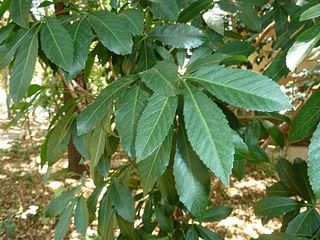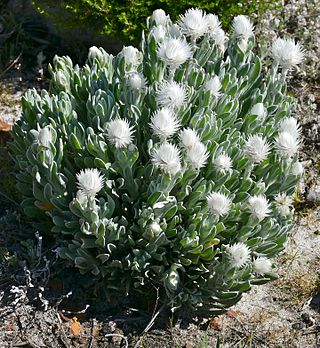
Curtisia dentata is a flowering tree from Southern Africa. It is the sole species in genus Curtisia, which was originally classed as a type of "dogwood" (Cornaceae), but is now placed in its own unique family Curtisiaceae.

Euclea, from the Greek eukleia meaning "glory and fame", denotes a group of flowering plants in the Ebenaceae or ebony family. They were described as a genus by Linnaeus in 1774. The genus includes evergreen trees and shrubs, native to Africa, the Comoro Islands and Arabia. Several species are used for timber, producing a hard, dark heartwood timber similar to ebony.

Searsia lancea commonly known as karee, is an evergreen, frost hardy, drought resistant tree, which can reach up to 8 metres in height with a 5-metre spread. It is one of the most common trees on the Highveld and in the Bushveld in South Africa, but not found in the Lowveld. In North America, where it is naturalized, it is known as African sumac and willow rhus.

Kalanchoe thyrsiflora is a species of flowering plant native to Botswana, Lesotho, South Africa and Eswatini. This plant is rare in cultivation, and those plants labelled as "Kalanchoe thyrsiflora" in horticulture are mostly another similar species, Kalanchoe luciae.

Syncarpha is a genus of herbaceous flowering plants in the family Asteraceae. The flowers are known by the common name: everlastings. The genus is endemic to the fynbos of the Eastern and Western Cape in South Africa.

Dimorphotheca sinuata, the glandular Cape marigold, Namaqualand daisy, or orange Namaqualand daisy; syn. Dimorphotheca aurantiaca hort.) is a species of plants native to southern Africa. It is also widely cultivated as an ornamental and naturalized in parts of the United States, primarily California and Arizona.

Dichrostachys is an Old World genus of flowering plants in the family Fabaceae. Their Acacia-like leaves are bi-pinnately compound. Unlike Acacia their thorns are hardened branchlets rather than modified stipules. They are native from Africa to Australasia, but a centre of diversity is present in Madagascar.

Widdringtonia wallichii, Clanwilliam cedar or Clanwilliam cypress, previously Widdringtonia cedarbergensis is a species of Widdringtonia native to South Africa, where it is endemic to the Cederberg Mountains northeast of Cape Town in Western Cape Province. It is threatened by habitat loss and protected in South Africa under the National Forest Act of 1998.

Oldenburgia is a genus of flowering plant in the family Asteraceae. It contains four accepted species, including the commonly cultivated, near-endangered species Oldenburgia grandis (Thunb.) Baill. ; the petricolousOldenburgia paradoxa Less. (type-species); Oldenburgia intermedia Bond ; and Oldenburgia papionum DC. Oldenburgia herbacea (L.) Roxb., an unresolved name.

Coleonema is a genus of flowering plants in the family Rutaceae. The eight known species are all from the western Cape Province of South Africa. In Australia, where they are cultivated as garden ornamentals, they are often referred to as Diosma, a different genus in the same family.

Senecio tamoides, also known as Canary creeper, false grapevine, and parlor ivy, is a climbing member of the genus Senecio of the family Asteraceae that is native to Southern Africa. It is used as an ornamental plant for its showy yellow, daisy-like flowers in late autumn through to winter.

Gazania rigens, sometimes called treasure flower, is a species of flowering plant in the family Asteraceae, native to coastal areas of southern Africa. It is naturalised elsewhere and is widely cultivated as an ornamental plant.

Phaenocoma is a genus of South African plants in the tribe Gnaphalieae within the family Asteraceae. The name is derived from the Greek roots φαίνω and κόμη (hair), which refer to dry and shiny involucral bracts.

Asparagus densiflorus, the asparagus fern, plume asparagus or foxtail fern, is a variable evergreen perennial plant, closely related to the vegetable asparagus.

Dimorphotheca cuneata, commonly known as the rain flower or white bietou, is a plant species native to the Cape Provinces and Free State of South Africa. as well as the Botswana and Namibia. It is also widely grown as an ornamental and reportedly sparingly naturalized in Gila County in the US State of Arizona.

Allophylus natalensis, commonly known as the dune false crowberry or dune false currant, is a species of plant in the genus Allophylus native to south-eastern Africa.

Syncarpha vestita is a species of flowering plant. It belongs to the genus Syncarpha, and family Asteraceae. It is endemic to the Cape Provinces of South Africa.

Syncarpha speciosissima, the Cape everlasting or Cape sewejaartjie, is a species of plant from South Africa.


















